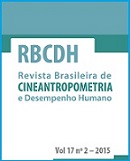Effect of different rest intervals between sets in the growth hormone concentrations in trained older women
DOI:
https://doi.org/10.1590/1980-0037.2015v17n2p216Abstract
The use of shorter rest intervals (RI) between sets of weight exercises has demonstrated to be a strategy to cause elevations of growth hormone concentrations (GH) in young adults. However, is not yet well established whether the magnitude of these elevations is influenced by the aging process. Thus, the aim of this study was to analyze the effect of different RI between sets of weight exercises on GH concentrations. Eighteen trained older women (65.8 ± 4.4 years; 70.2 ± 11.8 kg; 158.2 ± 5.1 cm) were submitted to two experimental exercise sessions in the leg press (separated by intervals between 48 and 72 hours). Both sessions consisted of three sets all performed with absolute loads of 15 maximal repetitions. Participants were instructed to perform maximum repetitions possible in each set until volitional muscle fatigue. In each experimental session, one of the different RI between sets was used: one minute (RI-1) or three minutes (RI-3). A randomized cross-over balanced design was used to determine the order of experimental sessions. Blood samples were collected to determine GH concentrations immediately before and after leg press exercise. Only the session performed with RI-1 showed significant elevations (50.7%; P < 0.05) in GH concentrations after exercise. However, significant differences in post-exercise GH concentrations were not observed between RI (P > 0.05). The results suggest that the use of different RI between sets does not influence the GH concentrations in trained older women.



